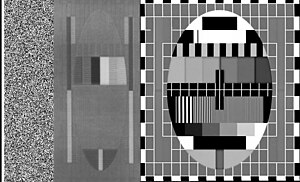



B-MAC[1] is a form of analog video encoding, specifically a type of Multiplexed Analogue Components (MAC) encoding. MAC encoding was designed in the mid 80s for use with Direct Broadcast Satellite systems. Other analog video encoding systems include NTSC, PAL and SECAM. Unlike the FDM method used in those, MAC encoding uses a TDM method. B-MAC was a proprietary MAC encoding used by Scientific-Atlanta for encrypting broadcast video services; the full name was "Multiple Analogue Component, Type B".
B-MAC uses teletext-style non-return-to-zero (NRZ) signaling with a capacity of 1.625 Mbit/s. The video and audio/data signals are therefore combined at baseband.
User base (PAL/NTSC zones)
MAC transmits luminance and chrominance data separately in time rather than separately in frequency (as other analog television formats do, such as composite video).
Audio and Scrambling (selective access)